If you see a small crawling creature with protruding antennae and multiple legs slithering along your wall or floor, chances are good that you will feel a tad unnerved. But is this multi-legged creature a centipede or a millipede? It's important to know the difference as centipedes are venomous, while millipedes are not.
Read on to learn more about these creatures and find out how to identify one from the other.
What are centipedes?
Centipedes are venomous and carnivorous creatures. All centipedes employ venom to kill their prey. They typically sting, immobilize and consume their prey, generally worms and insects. Although they usually aren't hostile towards people, they can bite if confronted. Centipede bites may be quite excruciating. The bigger the centipede, the more severe the centipede sting.
While anaphylaxis – a severe allergic reaction – from centipede bites is uncommon, the bite of a centipede can induce major allergic responses in persons who are hypersensitive to wasp and bee stings, as well as substantial cardiac and neurological damage.
Centipedes are primitive arthropods related to insects. The word "centipede" actually means "one hundred legs," although they can have anywhere from 10 legs to up to 300 legs. However, most adult centipedes have at least 15 pairs of legs.
You can recognize centipedes by their lengthy, segmented bodies with legs on every section. Centipedes are scavengers. They eat any small, crawling things they can find, such as spiders, crickets, cockroaches, silverfish – and even other centipedes.
What are millipedes?
Millipedes are also members of the arthropod phylum (a group of creatures designated by scientists via taxonomy) with two pairs of jointed legs on many of their body segments. However, they have two individual segments that are merged to form each double-legged section.
Most millipedes are detritivores, meaning their diet consists primarily of rotting leaves and other decaying plant material. Humans are largely unaffected by millipedes; however, some might become home or garden pests. Millipedes are particularly unwelcome in greenhouses, where they can seriously harm sprouting plants.
What do centipedes look like?
Centipedes are found in numerous colors, but most are reddish-orange or brown in hue. The centipede most prevalent in homes is the European and North American house centipede, as its name suggests. It has very long legs compared to the shorter, more hook-like legs of other centipedes. The house centipede can also be easily identified by the thick brown stripes running down the length of its segmented body. Although the more common house centipede is only one-inch to 1.5 inches in length, other centipedes can be significantly longer and bigger. Soil centipedes grow to as large as nearly eight inches.
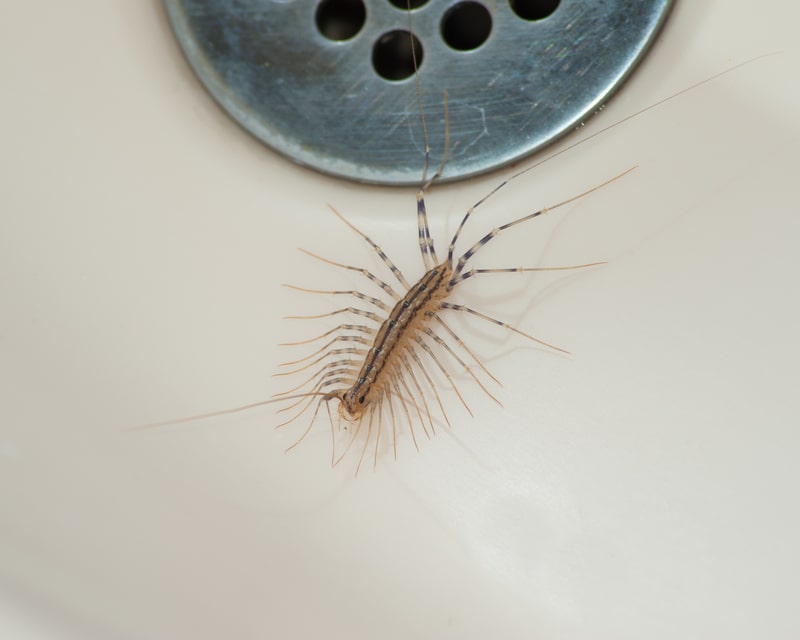
What do millipedes look like?
Millipedes have numerous pairs of legs and resemble tiny earthworms. In fact, they have leg pairs ranging from 40 to 400 pairs, although some can have up to 750 legs! They are usually black or brown. These foragers are typically brownish in hue and most range in length from 1/10" of an inch to one inch, although some can exceed 5 inches in length.
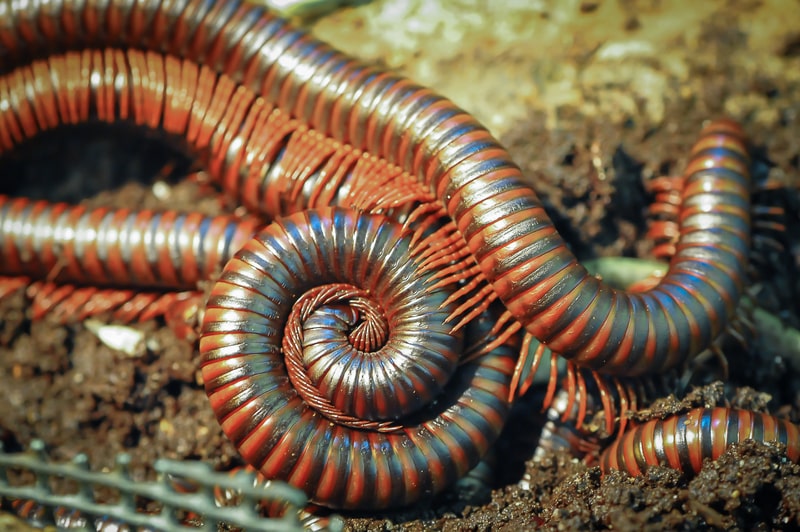
What are the differences between millipedes vs. centipedes?
While centipedes and millipedes may appear quite similar in appearance, there are a few differences. Millipedes have two pairs of limbs in each segment, positioned directly beneath their bodies. On the other hand, centipedes have one pair of legs in every segment, positioned on the flank.
Centipedes also have a flatter body when viewed from the side, whereas millipedes feature a rounder shape. Centipedes and millipedes react to danger in distinct ways. The typically more docile millipede will curl up and some will secrete a foul-smelling toxin, while centipedes can “bite" (or puncture skin) and flee swiftly. While millipedes may emit a toxin, the bite of a centipede can be poisonous and cause an allergic reaction.
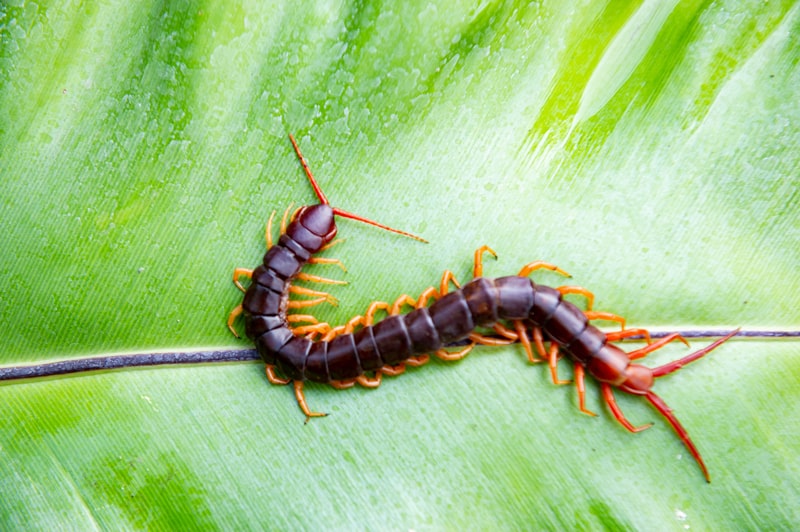
While centipedes are venomous and can impart a painful sting, millipedes do not bite. However, the toxin that millipedes release when threatened can cause an allergic reaction in some humans. In terms of diet, centipedes devour insects while millipedes eat decaying plants.
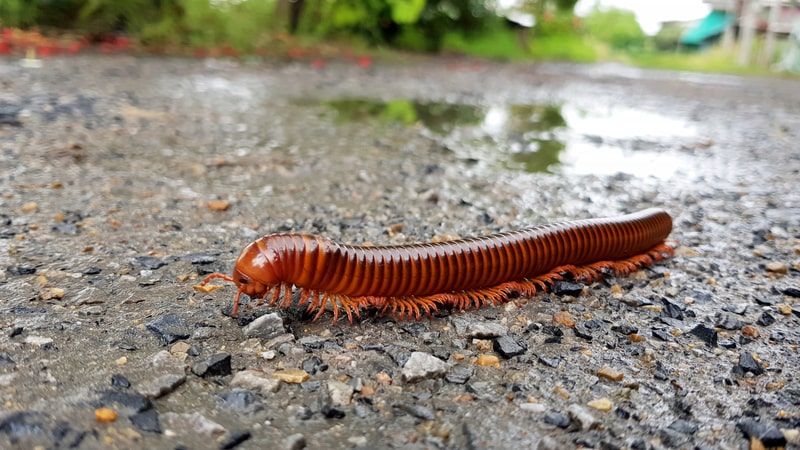
Centipede and millipede leg movements
Centipedes are fast-moving, while millipedes are slow-moving. Centipedes can easily make their way through diverse terrain by synchronizing their leg motions, likely due to a distributed sensory input system. Millipedes move their limbs in a coordinated way that requires them to work as a team.
Millipedes get around by moving their limbs in a wave-like displacement along their bodies. Centipedes can also move at high speeds by slightly oscillating, or their bodies while moving. Centipede legs also get longer and closer to the tail, allowing for a wider walk by avoiding the limb in front.
Do centipedes bite humans?
Centipedes will attempt to escape when cornered and can “bite" – more accurately, “pinch" – a human. However, if you see marks on your skin after a run-in with a centipede, it's most likely a perforation caused by centipedes' forelegs scratching and puncturing your skin.
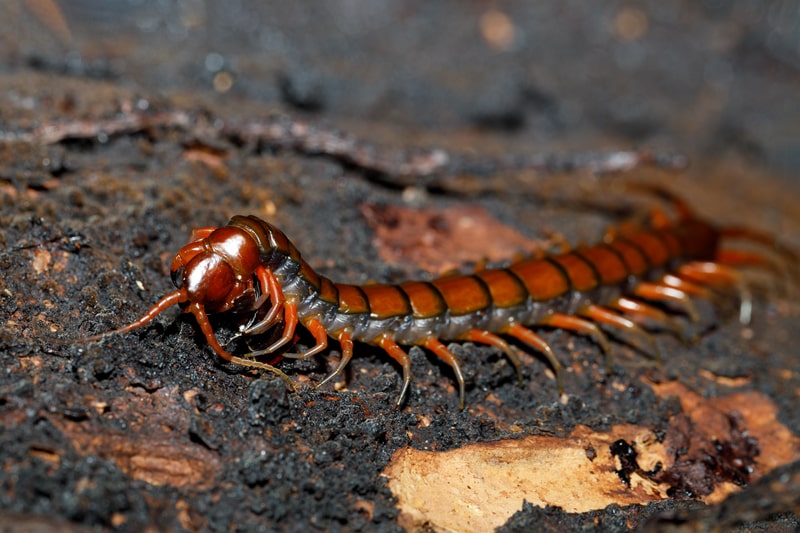
What happens if a centipede bites you?
Centipede bites can have a variety of effects.
Common symptoms of centipede bites
Apart from blistering, pain, and swelling, other symptoms to watch for after a centipede bites are:
- Redness around the bite
- Numbness around bite on some occasions
- Swelling of lymph nodes
- Itching
- Headache
In the event of a severe allergic reaction to a centipede bite, you may observe the following symptoms:
- Difficulty breathing
- Throat swelling
- Elevated heart rate
- Hives
- Drowsiness
Treatment and caring for centipede bites
- Seek professional medical attention.
- Clean the bite with soap and water. Do not use alcohol.
- Apply a cold compress to the injury in 10-minute intervals, on and off. Repeat the procedure until pain and swelling goes away. It's worth noting that a warm compress can make it feel worse.
- Continue to monitor the afflicted area.
- In the event you observe symptoms worsening, feel sick, or are seeing signs of an allergic reaction, contact poison control or go to the emergency room immediately.
- For less severe bites and resulting pain, try an over-the-counter drug such as an antihistamine if you need to alleviate the symptoms.
Do millipedes bite humans?
No. Millipedes aren't known for being aggressive, and they don't employ venom to immobilize prey. If threatened, millipedes will typically coil up until the threat has gone. Sometimes they'll secrete a foul-smelling toxin. If you suspect a severe reaction from coming in contact with this secretion, consult a physician as it can cause an adverse reaction in some individuals.
Centipede life cycle
Centipedes have a simple (or incomplete) metamorphosis cycle, taking them from egg to nymph to adult.
Centipedes mate in the summer and hibernate in the winter. Female centipedes typically lay eggs in soil. The larvae hatch a few days later and emerge as a smaller version of adult centipedes with fewer body segments and legs. Over the course of 21-25 weeks, centipedes can molt up to seven times, developing new segments and legs with each successive molt. A centipede's lifespan can be as long as six years.
Millipede life cycle
Millipedes have a similar life cycle to their centipede arthropod cousins, as well as an even longer life span. Female millipedes may lay up to 300 eggs at a time in soil. The eggs hatch several weeks later. The emerging nymphs molt seven or eight times over the course of several years before they fully mature.
What do centipedes eat?
Centipedes are carnivores and do not eat plants. Instead, centipedes eat a variety of small insects, such as silverfish, spiders, crickets, moths, silverfish – and sometimes even other centipedes.
What do millipedes eat?
Millipedes are omnivorous, although they typically eat dead or decaying plants. However, if it is the only option available to them, they will eat live plants or dead animals.
What eats centipedes and millipedes?
Toads, shrews, birds, badgers, and birds such as domestic chickens eat centipedes and millipedes. Juvenile millipedes and centipedes are prey for by ground beetles, spiders, and ants.
Centipede habitat and behaviors
Centipedes favor damp, dark places. They can often be found in soil beneath stones or under mulch and wood piles. When indoors, centipedes can lurk in moist, humid areas such as bathrooms, closets, or basements / attics.
Millipede habitat and behaviors
Millipedes prefer to reside in moist places outdoors, such as in loose soil. When temperatures turn cold and the ground becomes hard, they may migrate indoors. When inside the home, millipedes tend to stick to lower floors, such as the basement, although the damp nature of a bathroom is particularly favorable hospitable for these arthropods.
Common types of centipedes
Some of the most common types of centipedes in North America are:
- Desert centipedes: These centipedes primarily live under logs and rocks throughout the US and Northern Mexico.
- House centipedes: These are the most common centipedes that are found indoors. They have long legs that allow them to climb walls and skitter across floors.
Common types of millipedes
According to arthropod research, millipedes are numerous and diverse, with 1,400 species in North America alone and more than 7,000 species worldwide. Garden millipedes are among the most common millipedes you may find indoors and infesting greenhouses.
Are centipedes harmful to people or pets?
Most centipedes do not carry disease-causing pathogens and are often not harmful to people or pets. In rare instances, their “bite" may cause a severe allergic reaction in humans. Where it concerns pets, it's rare that a centipede bite will cause an allergic reaction, although the size of your pet and size of the centipede that delivers the bite can play a role in your dog's reaction.
Are millipedes harmful to people or pets?
When threatened, millipedes do not bite, but emit a toxin designed to deter predators. While this toxin smells bad, allergic reactions are rare among humans who come in contact with it. Similarly, if your pet eats a millipede, they are generally safe. However, if the millipede secretes its toxin while your pet was eating it, they may vomit and experience discomfort. These symptoms typically resolve after a day. If the symptoms continue beyond a 24-hour period, be sure to take your pet to the vet to get checked out.
Are house centipedes harmful?
House centipedes do not pose a significant hazard to people. In the event of a centipede sting, mild aching and swelling are the most common adverse effects of, although people who are allergic to house centipedes may have more adverse effects.
Are millipedes poisonous?
No. Millipedes are not poisonous, nor are they or carriers of disease-causing pathogens. They do, however, produce a foul-smelling fluid that they spray when they feel threatened. This toxin may contain hydrochloric acid, which can hurt your eyes or irritate the skin if a person comes in contact.
How can I prevent centipedes and millipedes from getting into my home?
Because centipedes and millipedes are attracted to shelter and humidity indoors when outside conditions aren't optimal, management begins with providing dry and clean settings. Seal any fractures, holes, or openings in your foundation or around doorways that centipedes may exploit to get inside.
What are the signs of a centipede infestation?
The most obvious sign of a centipede infestation is actually seeing one of these creatures for yourself. They are typically nocturnal, so you may not always see them. However, they are attracted to such insects as cockroaches and silverfish, so if you have them, centipedes may follow.
What are the signs of a millipede infestation?
While seeing a millipede (or several) for yourself may be a clear sign of an infestation, unlike centipedes, millipedes can impart damage to the structure of your home. Because they eat decaying plant matter like mulch or wood, they may be attracted to using the walls of your home or garden as food.
How to get rid of centipedes from your home
Getting rid of centipedes in your home starts with prevention. Caulk and seal gaps where they may be able to enter. Because centipedes are attracted to damp places, you can make your home less attractive to them by using a dehumidifier and by running fans to reduce moisture. In your backyard or areas directly outside the home, be sure to keep mulch, dead leaves, and wood a safe distance away. Regular cleaning and decluttering can also make your home less hospitable to centipedes, giving them fewer places to collect.
How to get rid of millipedes from your home
Because millipedes are attracted to damp areas, many of the same tenets to get rid of centipedes also apply. Seal any foundational cracks or areas where they could potentially enter, or repair leaky faucets or pipes that can not only serve as an entry point for millipedes, but also create a moist environment. You should also consider using a humidifier or fans to decrease humidity in areas of your home more prone to dampness.
Outside the home, clearing your yard of dead leaves and keeping mulch or wood away from your home not only removes hiding places where millipedes can lurk, but also removes a significant food source as they feast on decaying plant matter.
How Terminix® Helps You with Centipede and Millipede Control
Terminix® can help protect your home from centipedes and millipedes for as long as you retain your plan. We will conduct an initial examination and treatment of your home's interior and exterior. If pests reappear between appointments, we'll return as well — at no extra charge to you for the duration you keep your plan. Reach out to us today.


